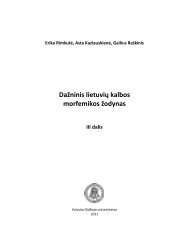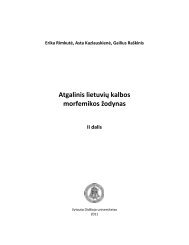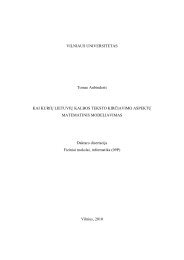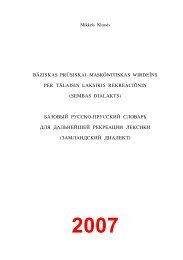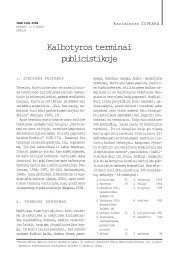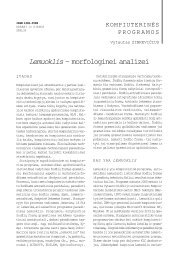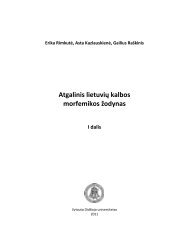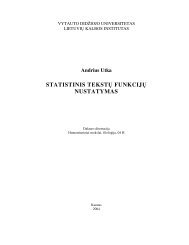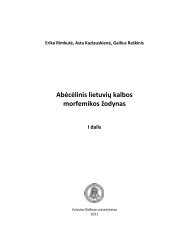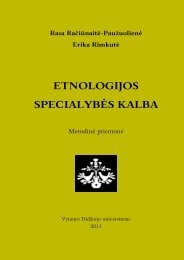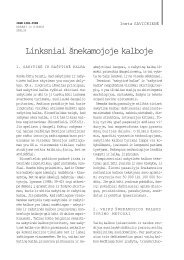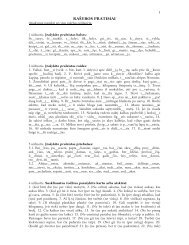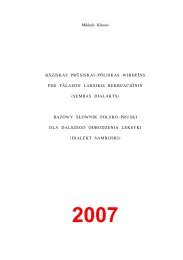HISTORICAL GRAMMAR OF OLD PRUSSIAN
HISTORICAL GRAMMAR OF OLD PRUSSIAN
HISTORICAL GRAMMAR OF OLD PRUSSIAN
You also want an ePaper? Increase the reach of your titles
YUMPU automatically turns print PDFs into web optimized ePapers that Google loves.
<strong>HISTORICAL</strong> <strong>GRAMMAR</strong> <strong>OF</strong> <strong>OLD</strong> <strong>PRUSSIAN</strong><br />
Pr. (Cat.) gen. pl. *-an was supported by its phonetic coincidence<br />
with Pr. (Cat.) acc. sg. *-an, both forming so-called “general case” [casus<br />
generalis (acc. sg. = gen. pl.)]. It was the latter a-stem pattern, according<br />
to which an innovative i-stem gen. pl. (Cat.) *-in (cf. nidruwîngin III<br />
121 ) came into being.<br />
5<br />
* 100. Acc. pl. (masc.) Pr. *-ans (with undoubtful -‹an) is<br />
attested in the Catechisms, cf.: Deiwans (I, II, III) ‘deities’, t`wans (III)<br />
‘fathers’, etc., adj. maldans ‘young’, etc. This -ans cannot be easily put<br />
into connection with EBalt. acc. pl. -us (Lith. têvus = Latv. t…ev-us), plg.<br />
Bûga III 703 (although the problem of Pr. -ans is not discussed),<br />
Endzelîns BVSF 117, Stang Vergl. Gr. 186, Kazlauskas LKIG 176.<br />
I should like to reconstruct Balt. acc. pl. masc. *-#ôns which, in course<br />
of development, manifested in 2 allomorphs (cf. ** 18, 19):<br />
1) as an accented Balt. *-×#ôns > EBalt. *-×#ôs40 > Lith.-Latv. -us (cf.<br />
Endzelîns l. c., Stang l. c., Kazlauskas l.c.), and<br />
2) as an unaccented Balt. *-#`ns > WBalt. *-#`ns > Pr. -ans (cf. Stang<br />
l. c.). This WBalt. *-#`ns coincided with WBalt. acc. pl. fem. *-#`ns41 which<br />
had replaced an older WBalt. *-#`s < Balt. *-#`s (> Lith.-Latv. -as), cf. BS<br />
185 ff., 311 f.<br />
* 101. Rosinas BÁM 82 ff. (with bibliograhy) has formulated a<br />
hypothesis that Pr. acc. pl. masc. -ans goes back to Balt. *-ôs which, when<br />
unstressed, turned into WBalt. *-`s, but the latter, due to “secondary nasalization”,<br />
turned into Pr. *-…às, spelled as -ans in the Catechisms.<br />
40 V. Maþiulis explains East-Baltic denasalization in *-×#ôns due to mostly redundant character of<br />
its -n- in plural in the opposition acc. sg. *-an : acc. pl. *-×#ôns, cf. BS 188. For an alternative view<br />
that Eastern Baltic never possessed acc. pl. *-×#ôns but developed its acc. pl. *-×#ôs independently,<br />
cf. Palmaitis BGR 100 f. – L.P.<br />
41 The assumption of this secondary acc. pl. fem. *-#`ns in Western Baltic had to explain the<br />
survival (due to systemic reasons) of acc. pl. masc. *-#`ns in spite of its redundant -n- (BS ibid.).<br />
For an alternative view of -n- formally transferred into Prussian masculine and feminine plural in<br />
accordance with the pattern *-an in singular, cf. Palmaitis ibid. – L.P.<br />
47



